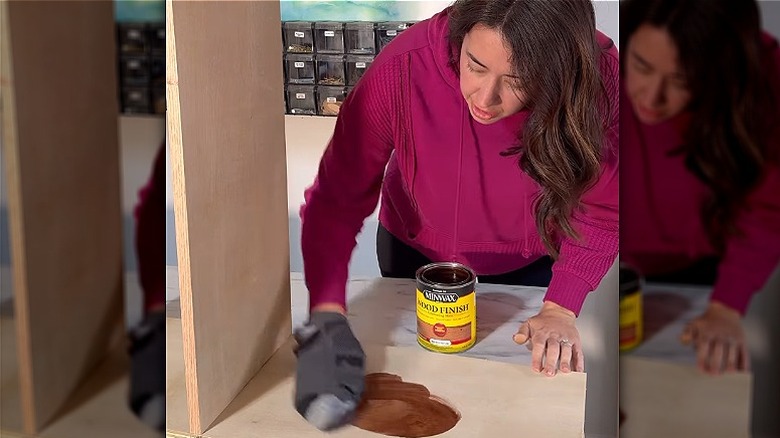The Wood Staining Hack That Gives Mismatched Socks A Useful Purpose
Staining wood is messy work, and once you add up all the supplies needed, it can also be costly. If you're not a fan of spending money on brushes, specific rags, and other tools, you might be pleased to find out there's a frugal tip to follow when staining wood. Everyone knows that it's common to find extra socks that are missing their perfect match. Many people also have a pile of socks that have small holes as well, rendering them useless for their intended purpose. When it's time for your next staining project, repurpose your mismatched socks or damaged pairs by using them to give your wood a perfectly even coat of stain.
For this hack, you'll need an old sock or two as well as a Ziploc bag or glove and your can of wood stain. Begin by putting your hand inside a plastic bag or putting the glove on. Next, you'll need to grab your sock, putting your gloved hand inside of it so that it can be immersed in a can of wood stain. Once you have the sock on your hand, you'll want to dip it into the wood stain until it is thoroughly wet with stain but not dripping. Now, use your hand to spread the stain over your wooden surface. When the sock gets too dry, re-immerse it and repeat the process until the staining is complete. Instagram user @delancey.diy highlights that this wood staining hack is budget-friendly and great for reaching into tight corners.
Tips for this hack
As straightforward as this trick is, there are ways to tweak it to make it better suit your needs. For example, you may wish to experiment to see whether the outside or inside of the sock delivers smoother staining results. Some socks have a significantly fuzzier inside texture, which may be better if you're applying stain to a more porous wood like oak that will require more stain to saturate the grain. However, keep in mind that the lint may get stuck in your stain. If you're staining wood like maple, you might find that the finer texture of the outside of the sock will provide a thick enough application of stain.
After the sock has been used for a staining session, you'll probably need to discard it. The stain will dry and might change the sock's texture, making it useless for future staining. If you use an oil-based stain, when you are done using your stain-soaked sock, be sure to follow safe disposal guidelines, as oily rags can spontaneously combust if they are thrown away incorrectly. If you're just taking a brief break between coats, however, you may be able to extend the life of that particular sock by placing it in an airtight plastic bag or container. Avoid washing the oily sock in the washing machine as well, as this can result in an accidental fire. If you find yourself doing wood staining projects with any regularity, it could be a good idea to keep a plastic bag or bin in the laundry room to collect mismatched or damaged socks solely for this purpose.

